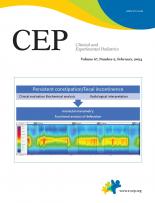Nonalcoholic fatty liver disease (NAFLD) is a concerning health condition that has increased in children and adolescents in recent years. NAFLD is defined as the presence of fat accumulation in more than 5% of hepatocytes without other causes that leads to inflammation and liver damage such as advanced fibrosis and cirrhosis [1]. With the increase in childhood obesity, NAFLD has become a significant health concern, affecting approximately 10% of all children and up to 35% of obese children [2,3]. In a recent study by Song et al. [4], the prevalence of NAFLD among Korean children and adolescents has increased from 8.17% in 2009 to 12.05% in 2018. The clinical spectrum of NAFLD in children ranges from simple fatty liver (steatosis) to nonalcoholic steatohepatitis (NASH), which involves inflammation and liver cell injury. If left untreated, NASH can progress to fibrosis, cirrhosis, and even liver failure.
The exact mechanisms underlying NAFLD development in children are not yet fully understood. It is believed that a combination of genetic, environmental, and lifestyle factors contributes to its pathogenesis. Risk factors include excessive caloric intake, sedentary behavior, unhealthy dietary habits, and certain genetic predispositions. NAFLD is strongly associated with central obesity and other metabolic comorbidities, including hypercholesterolemia, metabolic syndrome, and type 2 diabetes mellitus, with insulin resistance being the main pathogenic link between these conditions [4]. Therefore, the association between NAFLD and insulin resistance may be bidirectional. Insulin resistance can directly influence liver metabolism and contribute to NAFLD development. Insulin resistance leads to increased lipolysis in adipose tissue, resulting in the elevated release of free fatty acids (FFAs) into the bloodstream. These FFA are then taken up by the liver and contribute to fat accumulation within hepatocytes, leading to steatosis. Insulin resistance also affects the liver's ability to regulate glucose production. Insulin normally suppresses hepatic glucose production. However, this suppression is impaired in the presence of insulin resistance, leading to increased gluconeogenesis in the liver. Elevated glucose production further contributes to the metabolic dysregulation observed in NAFLD. In contrast, the accumulation of fat in the liver can worsen insulin resistance. Increased levels of intrahepatic triglycerides and other lipid metabolites can interfere with insulin signaling pathways within hepatocytes, leading to impaired insulin action and further promoting insulin resistance [5,6].
Many noninvasive methods, such as imaging studies or the pediatric NAFLD fibrosis index, have been proposed to date; however, liver biopsy remains the gold standard for diagnosing NAFLD despite high cost and difficulty. Liver biopsy enables the determination of disease severity, assessment of potential complications, and exclusion of other pathogeneses of the liver, such as Wilson disease.
The current recommendations for the management of NAFLD in children and adolescents primarily focus on weight reduction through lifestyle modifications (Table 1). Promoting a healthy, balanced diet with reduced caloric and sugar intake, increased physical activity, and weight management are key strategies. Dietary interventions and exercise act synergistically to reduce liver fat and improve hepatic insulin sensitivity [7]. The pharmacological management of NAFLD in children and adolescents is an area of ongoing research, and no specific medication has been approved to date. The proposed pharmacological management of NAFLD aims to reduce weight and treat dyslipidemia, hyperuricemia, and type 2 diabetes mellitus. In addition, dietary supplementation with vitamins E and D, polyunsaturated fatty acids, and probiotics has shown potential benefits of reducing liver inflammation and improving liver enzyme levels in pediatric patients with NAFLD and NASH. However, its long-term safety and efficacy in children and adolescents remain to be evaluated [8,9]. Metformin, an insulin-sensitizing agent, is not recommended for the treatment of NAFLD alone, although it is an important antidiabetic agent for controlling hyperglycemia.
In conclusion, NAFLD has emerged as a significant health concern in children and adolescents and is closely associated with the obesity epidemic. A timely diagnosis, comprehensive evaluation, and early intervention are essential to the management of NAFLD and prevention of its long-term complications. Additionally, obesity prevention plays a vital role in addressing the NAFLD epidemic among children and adolescents. Public health initiatives, educational programs, and policy changes are required to promote healthy eating habits, physical activity, and overall wellness from an early age.





 PDF Links
PDF Links PubReader
PubReader ePub Link
ePub Link PubMed
PubMed Download Citation
Download Citation


